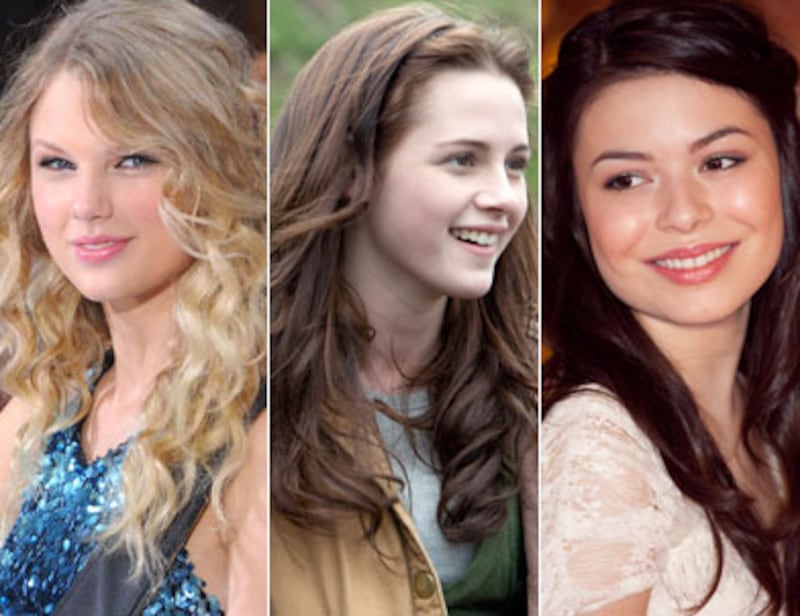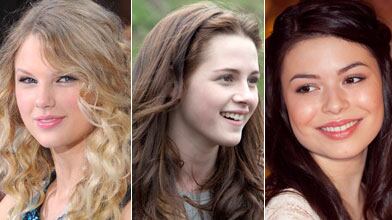Sex will always sell. This decade has been dominated by raunch culture, which, as defined by Ariel Levy in her excellent book Female Chauvinist Pigs, is women making sex objects of other women and of themselves. “Sex appeal,” Levy writes, “has become a synecdoche of all appeal.” It’s “empowering” women (as well as a lot of impressionable young girls) to wear a shirt with the Hustler logo, take cardio striptease classes, or get an $80 Brazilian wax. It’s Heidi Pratt with a bunny tan line on the cover of Playboy or the breakout stardom of fellow Playboy alumna Kendra Baskett.
CLICK IMAGE TO VIEW OUR GALLERY OF THE NEW GOOD GIRLS

But lately, raunch culture appears to be in remission. In its place is a new cultural paradigm: the nice girl.
Instead of being photographed getting carried out of bars at last call, nice girls, like Harry Potter star Emma Watson, enroll in Ivy League schools ( she’s headed to Brown). They, like Disney singer/actress Demi Lovato, give interviews about being bullied in school and how much they love their parents and best friends. They wear purity rings to show the world just how virginal they are, like American Idol’s Jordin Sparks. They are everywhere in teen culture: Abigail Breslin, Emma Roberts, Dakota Fanning, Taylor Swift, iCarly’s Miranda Cosgrove.
An adherence to modesty—the antithesis of the thong—is also intrinsic to the nice girl package, and we’ve seen it in the jumpsuits and maxi dresses in fashion this summer. The September issue of Teen Vogue, a magazine that has always championed niceness, has a story about how its readers can set appropriate boundaries with teachers, coaches, bosses, and other authority figures.
An adherence to modesty—the antithesis of the thong—is also intrinsic to the nice girl package, and we’ve seen it in the jumpsuits and maxi dresses in fashion this summer.
In Stephenie Meyer’s wildly popular book/film series Twilight, main character Bella Swan, despite being in love with a member of the undead, is a nice girl who cares for her bachelor dad. In Carlene Bauer’s recent, buzzy, no-sex and the city memoir, Not That Kind of Girl, she writes of being the sort of high school student that reads Seventeen’s sex advice (which she describes so accurately as “about as titillating as the breakdown of active ingredients on a tube of Vagisil”) but is too preoccupied with nuclear war, Regency England, and Sylvia Plath to put any of the teen magazine's sex tips into practice.
Of course bad girls have not—and will not—go away. Cobra Starship’s latest hit single “ Good Girls Go Bad” has a cameo by Gossip Girl star Leighton Meester in which she sings about the allure of corruption: “But just one night couldn't be so wrong/ You make me wanna lose control.” Her co-star, Taylor Momsen, she of the bleached shag and raccoon eyeliner, seems to be modeling herself in the image of Courtney Love. But Gossip Girl is routinely getting trounced in the ratings by ABC Family’s The Secret Life of the American Teenager. It’s a show whose protagonist is no virgin—she’s actually a teen mom—but the emphasis is on responsibility and life lessons—two qualities largely absent from the debauchery and social intrigue of Gossip Girl.
MTV’s summer hit 16 and Pregnant is a documentary-style show whose first season focused each week on a different teen mom, from pregnancy to infancy. Like Secret Life, it focuses on girls who’ve done something usually considered bad by society and chronicles their road to maturity. Contrast that with another MTV show, The Hills, home of Heidi Pratt, whose most recent fifth season saw a ratings drop of 15% from the season before. Perhaps sensing bad girl fatigue, MTV ordered up another season of 16 and Pregnant and a show called The Buried Life that follows four Canadian boys (boys are not immune to the culture of niceness) who travel across North America doing good deeds.
Nicole Ritchie and Christina Aguilera, two poster girls for early 21st century badness, have rehabilitated their reputations and are now best known as devoted moms. Mischa Barton and Lindsay Lohan, who have as yet not joined the nice girl bandwagon, are meanwhile shown in the press as examples of how not to behave. (Barton’s recent hospitalization for ‘ exhaustion’ raised more eyebrows than sympathy.)
Despite their status as pinups, Pratt and Baskett trade on a certain perfunctory goodness: Pratt is a devout Christian who refused to pose completely nude and Baskett’s reality show emphasized her devoted, monogamous relationship (in contrast with her precious relationship as one of Hugh Hefner’s three girlfriends) and excitement at expectant motherhood. (Again, there’s the pregnancy as shortcut to being nice. Lohan’s most recent artistic output was in the TV movie Labor Pains, in which she improved her life by pretending to be pregnant.)
The problem with nice is that it doesn’t particularly encourage a full range of emotions. Nice girl culture doesn’t give much in the way of advice for how to deal with normal conflict or disappointment.
But all this niceness can be stifling. Rachel Simmons, author of Odd Girl Out and the founder of the Girls Leadership Institute, takes a critical look at the pressure to be nice in her new book The Curse of the Good Girl. “Unerringly nice, polite, modest, and selfless, the Good Girl is a paradigm so narrowly defined that it’s unachievable.”
The problem with nice is that it doesn’t particularly encourage a full range of emotions. Nice girl culture doesn’t give much in the way of advice for how to deal with normal conflict or disappointment. As a result, Simmons finds that good girls are paralyzed by self-criticism.
“Without having robust models of revolt that mainstream culture embraces, young girls are far less likely to explore their own self-defined, diverging paths,” writes Maria Raha in her book Hellions: Pop Culture’s Rebel Women. Uniformly nice culture creates female personae that is just as limiting as raunch culture’s ersatz rebellion. What girls need is to be encourages to show a range of traits: The good, the bad, and the full spectrum in between.
In Not That Kind of Girl, by the time Bauer has become one of the “virginal and staunchly sober girls” at a Catholic college, she also finds the rebellion of the early ‘90s unavoidable. It was a time when girls were trading their perms for Manic Panic hair dye, singing along to Liz Phair, purging their closets of any traces of floral prints, and keeping their legs “profoundly unshaven.” Her weekends as an undergrad might include hanging out at Tower Records (“Stone cold sober. Fully dressed”), attending a pro-choice march, and still making it to church on Sunday morning. Bauer was able to become the kind of girl who was both rebellious and pious, good and little bit bad. It’s the kind of life you can’t easily label, but hopefully one more girls will consider adopting.
Marisa Meltzer is coauthor of How Sassy Changed My Life. Her next book, Girl Power, will be published by Farrar, Straus and Giroux in February.





